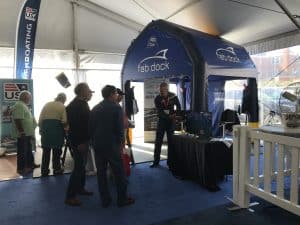South Australia for FAB Docks, Crayfish and Wine
If you havn’t been to Robe in South Australia, put it on your must do list. This is one of our favourite towns in all of Australia. It is one of the hidden gems that only the locals know about. Well, at least until lately. Having never had to book a room in town before, we found ourselves trying to work out how we could rearrange the three FAB Docks in the back of our van so that we could sleep in there as well, before we found the last remaining room in the Caledonian Inn. A hotel long on history (first licensed in 1858) but short on door height.

And with more boats pleasure boats in FAB Docks than not, it is easy to see why we come here so often. Yes that is 7 boats all protected by FAB Docks!

And when the locals insist on taking you out boating, it is not the relaxing, lazy drinking and eating journey that we enjoy up here on the Gold Coast. It is serious work in the unprotected Southern Ocean. Next stop; Antarctica.
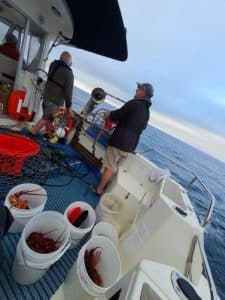
But it is all worthwhile when you have a successful morning pulling up the pots.
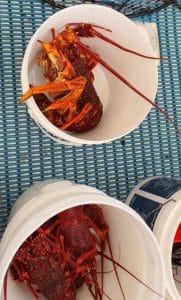
And the rewards are enjoyed well into the night.

And no trip to South Australia is complete without a stop in to a winery or two. But not even my namesake could get me any discounts or favours here.

And for those that know Dean, no meal is complete without desert, or a milkshake. So why not have both.

Osmosis and Gelcoat Blisters
The very mention of these words is enough to send shivers through the most experienced of fiberglass boat owners. For those less experienced, the nearest analogy would be like finding rust in your car. Yes, it can be treated, but left unchecked will ultimately result in the death of the vehicle or vessel.
Osmosis is caused when water penetrates the outer gelcoat layer of the boat and finds its way into the layers of fiberglass. If these layers aren’t bonded properly, this water starts to delaminate these layers which can eventually affect the integrity of the hull and render the vessel unsafe. Gelcoat blisters are formed when water has penetrated the gelcoat layer and reacts with the chemicals of the gelcoat. When broken, these blisters quite often leak a dark fluid that is quite pungent. Gelcoat blistering is often the precursor to the more serious problem of osmosis and is therefore much easier and cheaper to fix, if found early enough.
How can this happen? Surely a fiberglass boat is waterproof? After all, it is designed to be on the water. That is what I thought when I bought my first boat too. But no, fiberglass boats are not waterproof. Gelcoat is actually porous. Most boat owners don’t believe me when I tell them, so it is off to the all-knowing Google to clarify and prove the point.
So yes, they make boats out of materials that aren’t waterproof. But what if you want to leave your fiberglass boat in the water? How do I stop it from getting gelcoat blisters or osmosis? In days gone by, most boat owners would apply antifoul (or bottom paint as it is called in the US) to the bottom of the boat. Before the antifoul is applied, most reputable companies would prepare the hull by sanding back the shiny gelcoat and applying a coating of epoxy. This would act as a sealant for the boat and give the antifoul something to stick to. And in the worst case scenario, would also hide any blistering that has already occurred or may occur at a later stage.
This process was so prevalent that a lot of boat manufacturers didn’t even bother finishing the fiberglass below the waterline properly as they expected every boat owner to sand it back anyway and apply antifoul. However, with some countries already banning the use of antifoul and many more looking at ways to outlaw its use because of the damage it does to our marine ecosystem, this option will not be available at some time in the near future.
Trailer boats are another peculiar situation. Manufacturers of smaller fiberglass boats assume that their boats will generally only be used for one day at a time and then housed back on the trailer. So any water that has infiltrated through the gelcoat layer will exit the same way it got in while it is sitting high and dry on its trailer. Therefore, they may not pay as much attention to the quality of their gelcoats as long as it looks shiny while sitting in the showroom.
The only problem with this theory is if their customer wishes to leave their fiberglass trailer boat in the water in an in-water dry docking system. Not all such systems are actually dry but we do know that a FAB Dock is and will keep your boat dry while it is inside its FAB Dock. However, every time the boat is out on the water, it is soaking up water. But unlike when it is sitting on a trailer, the water cannot drain back out of the gelcoat because it is wrapped up in the FAB Dock.
How do I solve this problem and make sure my boat doesn’t get osmosis or gelcoat blisters? A well made boat from a reputable boat builder is the first step. In over ten years, with hundreds of clean-skin boats living in FAB Docks, we have never had an issue. But that is no reason to be complacent. Even good boat builders can have bad days. Even Mercedes, Ferrari and Rolls Royce have warranty periods to cover any mistakes they make while producing their cars. And making a car is lot more exact, precise and repetitive than making a boat.
The manufacture of a boat is still reliant on the individual skills of the operators. The preparation of the mold, the application of the gelcoat, the tie layer and then layers of fiberglass matting and resin is the judgment call of the operator on any given day. And skilled operators can be difficult to find. In areas where boat building is prevalent like Florida or the Carolinas in the US or the Gold Coast in Australia, it might be a little easier to find skilled boat builders but smaller boutique builders in smaller centres really have to manage and train their staff carefully.
And even when you do get a well trained and motivated team together, a big weekend or a bad morning might result in less attention to a particular boat on any given day. And you definitely don’t want to end up with a “Friday” boat. That half finished boat at knock off time on Friday afternoon that now sits around all weekend picking up a layer of dust or moisture before it is finished off on the Monday morning. And even though gelcoats, fiberglass and resins have improved over the years and manufacturing processes have become more controlled, the pressures of business and quotas mean that boats are having to get popped out of their molds a lot sooner than they used to be, possibly before they have cured and settled properly. And if the operators have used more than half of their allotted amount of resin or matting on the first half of the boat, then the second half has to be a little thinner.
To combat all these possibilities, the best way to avoid any future issues is to have your fiberglass boat properly sealed by a professional shipwright. This involves the application of a waterproof coating to the bottom of the boat to prevent any water from penetrating the gelcoat. This will not only give you peace of mind but will also improve the resale value of the boat as more and more boat owners understand how important this is to maintaining the structural integrity of the hull.
Most shipwrights have their own preference as to what product they will use for this purpose. Some of the more popular products used for this application are epoxies, polyurethanes, two-packs and linear paints. There are also many companies coming up with new coatings all the time, such as Seacoat V10.
We strongly recommend that all of our customers talk to their local shipwright about what they recommend for their own boat and believe that it really is a worthwhile investment if you are planning on keeping your boat for any length of time.
This is even more important for owners of older boats. Like all materials and coatings, gelcoat breaks down over time and becomes even more porous. And if you add in the odd hole or crack, now you are inviting water into your boat. When you are going through the water at speed, you are now forcing the water into any little crack or hole in the gelcoat. It is like standing there with a pressure washer or water blaster and aiming it directly into every crack and crevice in your gelcoat. This accentuates any natural water ingress by a huge multiplier.
Again, if this boat is then removed from the water and allowed to dry out on a trailer or dry stack every day, this water will eventually find its way back out of your boat, usually. Not that I would rely on this theory to protect my boat form gelcoat blistering or osmosis.
This information isn’t meant to alarm or scare anyone but rather to educate fellow boat owners on a typical problem that is not commonly spoken about, particularly when purchasing a boat. So I hope this helps with protecting your investment and feel free to email our team if you have any further questions.
We wish you safe and happy boating.
Battery Maintenance – What you need to know
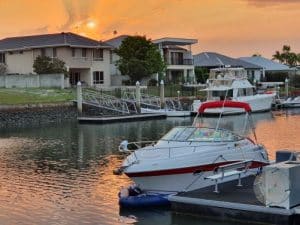
For decades, the battery of choice for all marine vessels has been the lead acid type. This will eventually change to other types such as lithium ion as technology drives the price down. However, for the foreseeable future, boat owners will be stuck with the downsides of the tried and true lead acid type.
Why Dry Docks are Great for your Boat
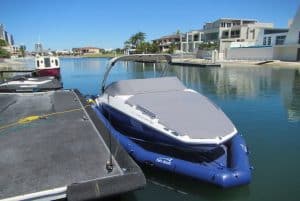
For decades, maintaining and repairing marine vessels has been an unrewarding task for boat-lovers the world over. The harsh conditions of saltwater have been a mighty adversary of submerged hulls for as long as our ancestors have been on the oceans. Whether you’re a professional boat mechanic or an avid saltwater angler repairing your own craft, there’s a better solution for you; FAB Dock has plenty of applications of dry docks for sale to help you with all your marine maintenance issues.
Why Australians love a Floating Dry Dock
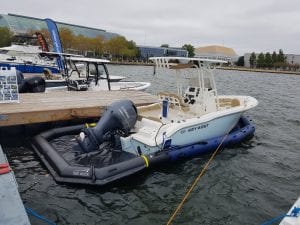
Picture the scene: you’ve just returned from a glorious Saturday’s boating off your local coastline. The tide is out and the water line is way too low for you to be able to dock your boat to the pier. Floating docks in Australia have become a big part of modern boating life, because they are the best, easiest and safest solution to this problem as well as many other many challenges involved in owning a marine vessel.
FAB Dock is based on the Gold Coast, where more than 200km of waterways have made the South-East Queensland location one of Australia’s most popular boating destinations. In an area this large, the speed with which you can assemble and reposition our inflatable floating docks has been a game-changer, allowing boatowners to focus on the fun element of boating – to enjoy more time navigating the city’s canals and seaways.
Know Your Boat Is Safe in Our Marine Docking System

FAB Dock founder and CEO Dean Howard has one of the most gratifying jobs in the world, being able to give all his customers the “peace of mind” of knowing their boating investment is safer with our marine dock system.
One of the most common phrases I hear from our FAB Dock customers all over the world is the peace of mind they now have, seeing their boats are safely tucked away and no longer exposed to the ravages of the saltwater environment. Their vessel stays clean and dry inside their FAB Dock marine dock system, until they venture out next time to enjoy their boat.
I feel exactly the same way. Without seeming too biased, I could never own a boat again knowing I had to keep it in saltwater, particularly a stern drive.
After another great weekend on our boat with my wife, we washed her, flushed her (the boat, not the wife), covered her up and now I am off for another few weeks in the United States to attend various boat shows [see our article on The Docks Expo in Nashville].
I’ll also meet with other dealers and install more FAB Dock marine dock systems, this time in Florida as the knowledge of how amazing our product is spreading rapidly overseas. All this time I’m away, I’ll be happy in the knowledge that my boat will be as clean and dry when I get home as it was the day that I left her.
If you value your boat and your time spent enjoying it, consider what that’s worth to you then include the value of our in-water marine dock system and you know it’s the right investment for you.
Dean Howard, FAB Dock founder & CEO
Team Success at The Docks Expo in Nashville




The FAB Dock team was thrilled to be representing the brand in the United States at The Docks Expo in Nashville in early December last year. The American trade show was a huge success for FAB Dock, with our founder and CEO Dean Howard showcasing our dry docks for sale, while mixing with top-tier marina executives and other high-profile industry representatives to show them just what our revolutionary product can do.
We wanted to shout out a big “thank you” to the organisers of the recent Docks Expo as it was clear what a huge extravaganza the trade show was to pull off. With more than 100 marina-focussed exhibitors, Dean says, “It was a fantastic show with dozens of great contacts from both marina owners and managers, as well as fellow marine professionals.”
Still using antifoul? For the love of the ocean, please stop.
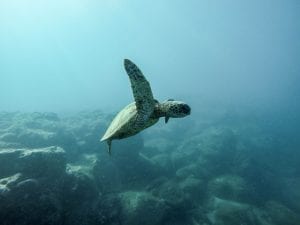
Humans are waking up to the consequences of plastics in our oceans. But what about the consequences of antifouling or bottom paint? Just because we can’t see it doesn’t mean it’s not hurting our marine creatures – and us.
You might have seen this viral video of a turtle getting a straw pulled out of its nose. Those images caused such outrage that they led to bans on plastic straws. Or you may have seen the pictures of seabirds lying on the beach, with bottle caps spilling out of their guts or the poor dead whale where 40kg of plastic bags were pulled out of its stomach. If you have, chances are you feel pretty bad about it. Those images probably make you think twice about the way you dispose of trash. Hopefully you’re not be the kind of person who would chuck a plastic bottle over the side of your boat or throw a plastic bag full of rubbish into the water. Because you love the water – that’s why you have a boat, isn’t it? A boat that takes you out into clear, blue seas and wide, open spaces. A boat that leads you to coral reefs where you can snorkel, dive and explore the wonderful underwater world. A boat that allows you to share in some of the planet’s most precious places – lakes, rivers and oceans.
Electrolytic Corrosion. Or, how come my prop dissolved?

Uh oh. You know you’re in trouble when one (or more…) of these things happens:
If you have an aluminium or steel boat:
- Blisters start appearing under your paint
- Pits form on the underwater areas of your boat
- Blisters pop up in lines along sharp edges such as chines and keels
- Corrosion appears, or white calcium deposits
- Paint peels off in sheets
- Metal components literally dissolve – sometimes in days.

